#huastec
Explore tagged Tumblr posts
Text




~ Hunchback Leaning on Staff.
Date: 10th–12th century
Place of origin: Mexico, Mesoamerica, Veracruz
Culture: Huastec
Medium: Sandstone
#history#museum#archeology#archaeology#10th century#11th century#hunchback leaning on staff#hunchback#Mesoamerica#Veracruz#Mexico#huasteca#huastec
453 notes
·
View notes
Text
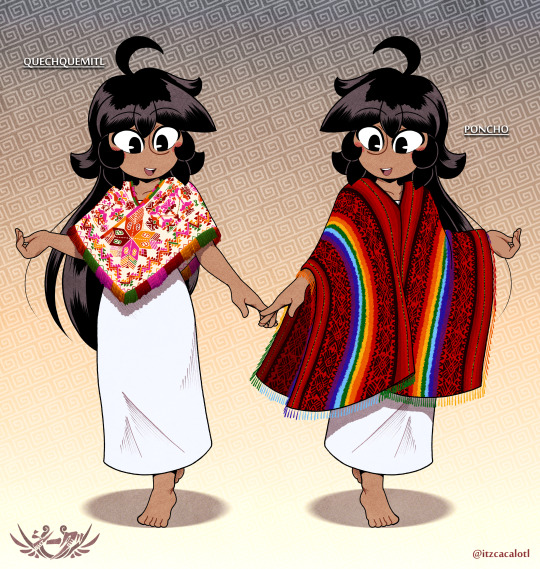
Donají, poncho vs quechquemitl
Did this for Codex Black's book 2. Donají's iconic garment is actually a quechquemitl, but I explain there why I use the word "poncho" instead.
This was a February P*treon reward!
The quechquemitl is the traditional one from the Huastec region, where this garment is believed to have originated. Meanwhile, the poncho is based on the traditional one from Cuzco, Perú.
#codexblack#codicenegro#donaji#original character#aztec#mesoamerica#huastec#peruvian#poncho#quezqueme#quesqueme#quexquemitl#quechquemitl
101 notes
·
View notes
Photo
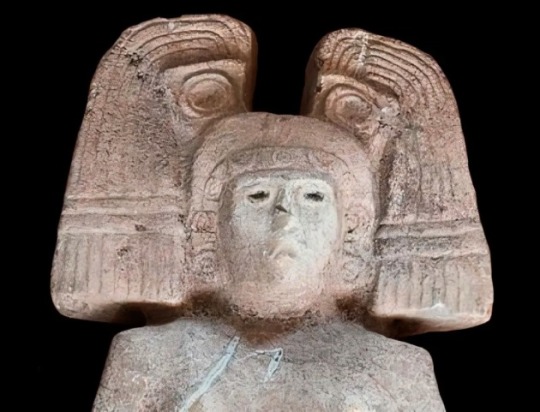

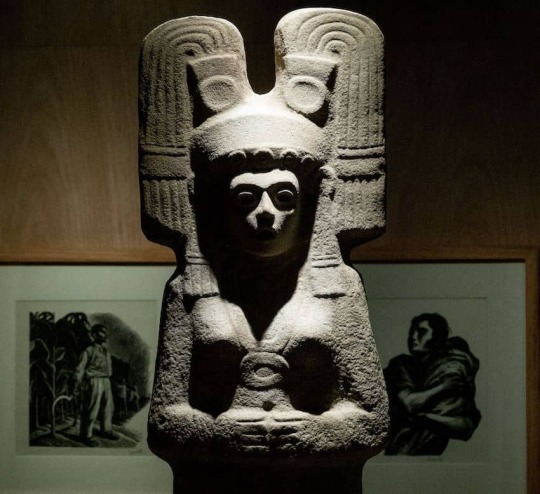
Pre-Columbian Statue Found in Mexico
The 6.5-foot-tall statue was found in a citrus orchard.
The region was ruled by the Huastec civilisation, an indigenous people of Mexico living in the La Huasteca region that includes the states of Veracruz, Hidalgo, San Luis Potosí and Tamaulipas – concentrated along the route of the Pánuco River and along the coast of the Gulf of Mexico.
Excavations of Huastec sites suggests that the culture emerged around the 10th century BC, with the most active period being during the Postclassic era between the fall of Teotihuacán and the rise of the Aztec Empire.
During the mid-15th century AD, the Huastecs were conquered by the Aztec during the reign of Moctezuma I (AD 1398–1469) but retained a large degree of local self-government by paying tribute to the Aztec Empire. The Huastec civilisation fell during the Spanish conquest between AD 1519 and the 1530s and were subsequently transported to the Caribbean to be sold as slaves.
The statue was discovered by workmen during road works in Hidalgo Amajac. According to archaeologists from the National Institute of Anthropology and History (INAH), the statue dates from the Early Postclassic period (AD 1100-1200) and was likely removed from a public space and buried for protection.
The statue measures 1.54 metres in height and weighs between 200 and 250 kilograms. It depicts a local ruler wearing a ceremonial headdress, similar to statues of rulers found in the pre-Columbian city of El Tajín.
This is not the first statue found in the Hidalgo Amajac area. In 2021, a 2-metre-tall statue called the “Young Woman of Amajac” was found in an orange grove depicting an indigenous woman wearing a headdress and an ankle-length skirt.
The mayoress of Álamo Temapache, Lilia Arrieta Pardo, announced that the cultural space currently being built in Hidalgo Amajac will be adapted to display the statue and the “Young Woman of Amajac”.
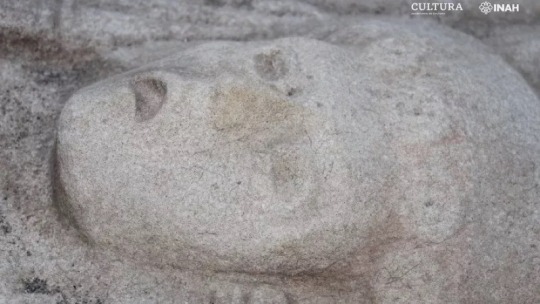
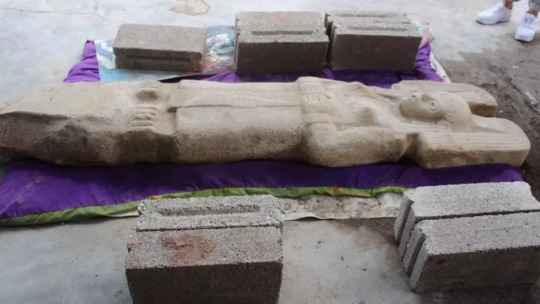

#Pre-Columbian Statue Found in Mexico#Huastec civilisation#sculpture#statue#ancient artifacts#archeology#archeolgst#history#history news#ancient history#ancient culture#ancient civilizations#ancient art
63 notes
·
View notes
Text
Why do some people rage against using the term Aztec, but say nothing when someone uses Maya (multiple cultures), Zapotec (Bën Za), Mixtec (Ñuu Savi Sukun, Ñuu I'ni, Ñuu Andivi), Tarascan (Purépecha), Huichol (Wixárika), Cora (Náayerite), Huastec (Téenek), or any other indigenous groups? Especially when discussing archaeologically defined groups/cultures that may be quite distinct from their contemporary descendants?
I'm not saying that we shouldn't use better terms. We most definitely should. Anasazi, for example, should never be used beyond a single sentence saying it is no longer an acceptable label when reviewing and discussing the historiography of the Puebloan peoples.
But that doesn't mean some terms should be abandoned in lieu of another term that is no way better. Replacing Aztec with Mexica ignores the two other ethnic groups/city-states that made up the Triple Alliance. I want you to stop and think And see if you can recall what those two groups were. I'll give you a hint, Nezahualcóyotl was from one of those groups.
Give up? They were the Acolhua and Tepanec. So, if you want to stop using Aztec, that's fine. But you have to replace it with Mexica, Acolhua, and Tepanec every time. However, that replacement is only limited to talking about Tenochtitlán, Texcoco, and Tlacopan. Why? Because there were more ethnic groups within the Basin of Mexico, not to mention outside the Basin of Mexico, that were under control of the Triple Alliance and were distinct from being Mexica, Acolhua, or Tepanec. You could, of course, replace Aztec with Triple Alliance, or Ēxcān Tlahtōlōyān in Classic Nahuatl. Totally fine if a little unwieldy. Though you may run into issues with people confusing the Triple Alliance of Mesoamerica with several Triple Alliances in European history.
But what really is the issue with using Aztec to refer to the multitude of ethnicities and cultures that made up the Triple Alliance? It isn't derogatory or insulting. The term is based on the semi-mythical homeland of numerous groups that occupied Central Mexico and made up a large part of the Triple Alliance (the Tlaxcalteca were from Aztlan, as well). In fact, Aztec is a handy term to refer to the collection of all these groups despite the polity not being a monocultural entity because these groups did share many cultural features, histories, and/or languages.
You could compare the term Aztec to Roman. A broad term that encompasses many peoples. But when necessary, you can discuss individual or small groups of ethnicities/cultures within the broader polity. And that includes the people of Rome itself which you could refer to as Romani, which they called themselves, to be distinct from the larger broader socio-political Roman label for the people of the Republic/Empire outside of Rome proper.
It's an issue of scale, I think. But that's why we have multiple terms available to use when the context and need arises. And if better terms come along, by all means replace the previous terms.
If you disagree, I would like to know why. This was sort of a rant into the void from seeing other online discourse. I really would welcome a good explanation as to why we should replace Aztec with Mexica at the expense of all the other groups that made up the Triple Alliance.
255 notes
·
View notes
Photo

Xipe Totec
Xipe Totec (pron. Xi-pe To-tec) or 'Flayed One' in Nahuatl, was a major god in ancient Mesoamerican culture and particularly important for the Toltecs and Aztecs. He was considered the god of spring, the patron god of seeds and planting and the patron of metal workers (especially goldsmiths) and gemstone workers. He is equivalent to the Red Tezcatlipoca, patron of Cuauhtli (eagle), the unfavourable 15th Aztec day-name and he was represented by the date 1 Océlotl.
Early Origins
Xipe Totec perhaps originated with the Olmec culture and developed from their ancient God VI. Another possible origin is from the Yope civilization in the southern highlands of Guerrero. The first representations of the god in art, however, date to the Post-classical period (9th to 12th century CE) in the Mazapan culture at Texcoco. The god was a major Aztec deity and was also worshipped by the Tlaxcaltecans, Zapotecs, Mixtecs, Tarascan and Huastecs. The late Post-classical Maya also adopted Xipe Totec and representations of the god survive at Oxkintok, Chichen Itza and Mayapan.
In Mesoamerican mythology Xipe Totec was the son of the primordial androgynous god Ometeotl and, specifically in Aztec mythology, he was the brother of those other three major gods Tezcatlipoca, Huizilopochtli and Quetzalcoatl. Sometimes credited with being a creator god along with his brothers, Xipe Totec was also closely associated with death, which resulted in him being considered the source of diseases amongst mankind. However, the god also received many offerings from worshippers calling for him to cure illnesses, especially eye ailments.
Continue reading...
144 notes
·
View notes
Text


“I am the fiery life of the essence of God; I am the flame above the beauty in the fields; I shine in the waters; I burn in the sun, the moon, and the stars. And with the airy wind, I quicken all things vitally by an unseen, all-sustaining life.” ― Hildegard of Bingen
Quetzalcóatl Talon Abraxas Quetzalcóatl (pron. Quet-zal-co-at) or 'Plumed Serpent' was one of the most important gods in ancient Mesoamerica. Quetzalcóatl was the god of winds and rain, and the creator of the world and humanity. A mix of bird and rattlesnake, his name is a combination of the Nahuatl words quetzal (the emerald plumed bird) and coatl (serpent).
In Central Mexico from 1200, the feathered serpent god was considered the patron god of priests and merchants as well as the god of learning, science, agriculture, crafts and the arts. He also invented the calendar, was identified with the Morning Star Venus, the rising morning star, he was associated with opossums and even discovered corn (maize) with the help of giant red ant that led him to a mountain packed full of grain and seeds. He was known as Kukulkán to the Maya, Gucumatz to the Quiché of Guatemala, and Ehecatl to the Gulf Coast Huastecs.
Quetzalcóatl was the son of the primordial androgynous god Ometeotl. In Aztec mythology he was the brother of Tezcatlipoca, Huizilopochtli and Xipe Totec. He is the 9th of the 13 Lords of the Day and is often associated with the rain god Tláloc. The god was particularly associated with the sacred site of Cholula, an important place of pilgrimage from 1200, and all round buildings of the Aztec culture were dedicated to the deity. In Central Mexico, the god was strongly associated with the wind, in particular as a bringer of rain clouds. A Creator God
In the Late Postclassical period (from 1200) in Central Mexico the god came to be strongly associated with the wind (in particular as a bringer of rain clouds) and as the creator god Ehecatl-Quetzalcóatl. In Postclassical Nahua tradition Quetzalcóatl is also the creator of the cosmos along with either his brother Tezcatlipoca or Huitzilopochtli and is one of the four sons of Tonacateuctli and Tonacacihuatl, the original creator gods. After waiting for 600 years this aged couple instructed Quetzalcóatl to create the world. In some versions of the myth Quetzalcóatl and Tezcatlipoca repeatedly fight each other and as a consequence the four ages are created and destroyed with each successive battle between the two gods.
In an alternative version of creation Quetzalcóatl and Tezcatlipoca are more cooperative and together they create the sun, the first man and woman, fire and the rain gods. The pair of gods had created the earth and the sky when they transformed themselves into huge snakes and ripped in two the female reptilian monster known as Tlaltcuhtli (or Cipactli), one part becoming the earth and the other the sky. Trees, plants and flowers sprang from the dead creature's hair and skin whilst springs and caves were made from her eyes and nose and the valleys and mountains came from her mouth. In some versions of the story the divine spirit of Cipactli was understandably upset to have lost her physical body in such a brutal attack and the only way to appease her was through the sacrifice of blood and hearts and so one of the more unpalatable practices of ancient Mesoamerican culture, the ritual of human sacrifice, was justified.
24 notes
·
View notes
Text

“A tenek (huastec) woman from the community of Tamaleton/Tamaletom, San Luis Potosi, Mexico. The olla she carries was probably made in the Nahua community of Chililico, Hidalgo” c.unknown
Instagram/friendswithclay
207 notes
·
View notes
Text


La Sirena de Boca del Río ~ en el estado Mexicano de Veracruz ~ escultor Ricardo Ponzanelli
La leyenda de la sirena en Veracruz y Guerrero, México (English translation):
"In the Veracruz imagination, the woman who became a mermaid has a first and last name. Her name, when she was human, was Irene Saavedra González and she lived, during the first years of the 20th century, in a small Huastecan town called Rancho Nuevo, near the lagoon. of Tamiahua in the north of Veracruz.
Irene was a beautiful young woman with dark skin, black hair and olive eyes. Her father, Abundio, had died. Her mother, Damacia, since she became a widow, had dedicated herself fervently to serving the Church, following to the letter all the uses and customs of the Catholic faith, which included hearing mass and not working in the fields. Holy days.
Legend has it that one Holy Thursday, Irene decided to go get firewood and, not happy with that, when she returned she told her mother that she wanted to take a bath because she was dirty and full of dust. Her mother warned her that it was not correct to bathe during Holy Week, but the young woman replied that at least she would go and wash her face.
It is said that Damacia heard her daughter's cries for help. When she came to help her, she saw the young woman transform into a being that was half woman and half fish. Her screams turned into a chant. Then, a huge wave covered her and dragged her down the river, towards the Tamiahua lagoon.
It is said that the residents of Rancho Nuevo wanted to help her and followed her in her boat to the lagoon. There a ghost ship appeared and Irene, now turned into a mermaid, jumped up and started shouting “peten ak, peten ak”, which in Tének or Huastec language means “turn, turn”. The animals in the lagoon revolved around her and formed a whirlpool into which she submerged. From her cry, “peten ak,” the name Petenera was derived."
25 notes
·
View notes
Text

Celestial Conch Shell with Skulls, Huastec, Veracruz (Northern), Mexico, 900–1521 Courtesy Alain Truong
7 notes
·
View notes
Text


Biotechnology and the future of humanity
The End Of Diversity
GM technology is also set to plunge countless thousands of people into poverty by using GM plants or tissue cultures to produce certain products which have up until now only been available from agricultural sources in the majority world. For example, lauric acid is widely used in soap and cosmetics and has always been derived from coconuts. Now oilseed rape has been genetically modified to produce it and Proctor & Gamble, one of the largest buyers of lauric acid, have opted for the GM source. This is bound to have a negative effect on the 21 million people employed in the coconut trade in the Philippines and the 10 million people in Kerala, India, who are dependent on coconuts for their livelihood. Millions of smallscale cocoa farmers in West Africa are now under threat from the development of GM cocoa butter substitutes. In Madagascar some 70,000 vanilla farmers face ruin because vanilla can now be produced from GM tissue cultures. Great isn’t it? 70,000 farming families will be bankrupted and thrown off the land and instead we’ll have half a dozen factories full of some horrible biotech gloop employing a couple of hundred people. And what will happen to those 70,000 families? Well, the corporations could buy up the land and employ 10% of them growing GM cotton or tobacco or some such crap and the rest can go rot in some shantytown. This is what the corporations call ‘feeding the world’.
Poisoning the earth and its inhabitants brings in big money for the multinationals, large landowners and the whole of the industrial food production system. Traditional forms of organic, small-scale farming using a wide variety of local crops and wild plants (so-called’ weeds’) have been relatively successful at supporting many communities in relative self-sufficiency for centuries. In total contrast to industrial capitalisms chemical soaked monocultures, Mexico’s Huastec indians have highly developed forms of forest management in which they cultivate over 300 different plants in a mixture of gardens,’ fields’ and forest plots. The industrial food production system is destroying the huge variety of crops that have been bred by generations of peasant farmers to suit local conditions and needs. A few decades ago Indian farmers were growing some 50,000 different varieties of rice. Today the majority grow just a few dozen. In Indonesia 1,500 varieties have been lost in the last 15 years. Although a plot growing rice using modern so-called ‘High Yielding Varieties’ with massive inputs of artificial fertilisers and biocides produces more rice for the market than a plot being cultivated by traditional organic methods, the latter will be of more use to a family since many other species of plant and animal can be collected from it. In West Bengal up to 124 ‘weed’ species can be collected from traditional rice fields that are of use to farmers. The sort of knowledge contained in these traditional forms of land use will be of great use to us in creating a sustainable future on this planet; it is the sort of knowledge the corporations are destroying to trap us all in their nightmare world of wage labour, state and market.
#biotech#classism#ecology#climate crisis#anarchism#resistance#community building#practical anarchy#practical anarchism#anarchist society#practical#revolution#daily posts#communism#anti capitalist#anti capitalism#late stage capitalism#organization#grassroots#grass roots#anarchists#libraries#leftism#social issues#economy#economics#climate change#climate#anarchy works#environmentalism
9 notes
·
View notes
Photo
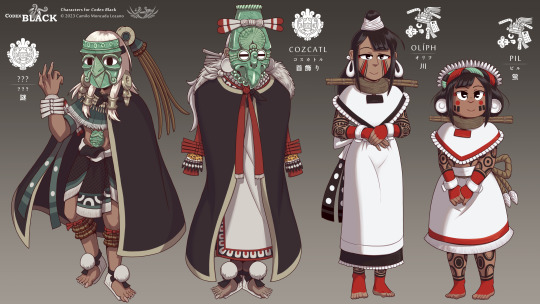
Codex Black characters!
It's been over a year since the last one I posted. Two of the main antagonists, and two Huastec gals! Most of my characters have regular body paint, but in the case of these Huastec girls, those are actual tattoos covering most of their bodies, as was common among Huastecs.
#CodexBlack#CodiceNegro#graphic novel#Character Design#original characters#mesoamerica#aztec#huastecan#teenek#huastec
154 notes
·
View notes
Text
Updated Pinned Post!
Hello! My name is Saturno and I'm a hobbyist artist and writer! I am bilingual Spanish and English with a couple years of Huastec Nahuatl on my belt! Current interests fluctuate but I mostly enjoy Hollow Knight, Legend of Zelda, and other miscellaneous media!
This blog will be my main, where I reblog whatever comes to my dash
@moth-party is my art and writing sideblog
@mothymusings is my book review blog
Hope you enjoy!

#ramblings#pinned post#new pin post#intro post#go follow my sideblogs I will be systematically removing my art from this one#and transplanting it to the new sideblog#my art
6 notes
·
View notes
Note
If you don't mind, my wife (who was adopted into a White family as an infant), has discovered she is Huastec, but hasn't really succeeded at finding meaningful resources to learn about her culture. Do you have any recommendations for places she could look or if there are modern Indigenous Mexican communities where people connect?
Hopefully someone can comment and provide some recommendations for you. The Huastec are one of my Achilles Heels when it comes to Mesoamerica
19 notes
·
View notes
Photo
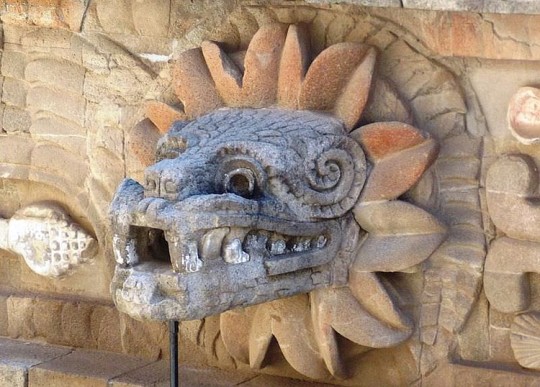
Quetzalcóatl
Quetzalcóatl (pron. Quet-zal-co-at) or 'Plumed Serpent' was one of the most important gods in ancient Mesoamerica. Quetzalcóatl was the god of winds and rain, and the creator of the world and humanity. A mix of bird and rattlesnake, his name is a combination of the Nahuatl words quetzal (the emerald plumed bird) and coatl (serpent).
In Central Mexico from 1200, the feathered serpent god was considered the patron god of priests and merchants as well as the god of learning, science, agriculture, crafts and the arts. He also invented the calendar, was identified with the Morning Star Venus, the rising morning star, he was associated with opossums and even discovered corn (maize) with the help of giant red ant that led him to a mountain packed full of grain and seeds. He was known as Kukulkán to the Maya, Gucumatz to the Quiché of Guatemala, and Ehecatl to the Gulf Coast Huastecs.
Quetzalcóatl was the son of the primordial androgynous god Ometeotl. In Aztec mythology he was the brother of Tezcatlipoca, Huizilopochtli and Xipe Totec. He is the 9th of the 13 Lords of the Day and is often associated with the rain god Tláloc. The god was particularly associated with the sacred site of Cholula, an important place of pilgrimage from 1200, and all round buildings of the Aztec culture were dedicated to the deity.
A Creator God
In the Late Postclassical period (from 1200) in Central Mexico the god came to be strongly associated with the wind (in particular as a bringer of rain clouds) and as the creator god Ehecatl-Quetzalcóatl. In Postclassical Nahua tradition Quetzalcóatl is also the creator of the cosmos along with either his brother Tezcatlipoca or Huitzilopochtli and is one of the four sons of Tonacateuctli and Tonacacihuatl, the original creator gods. After waiting for 600 years this aged couple instructed Quetzalcóatl to create the world. In some versions of the myth Quetzalcóatl and Tezcatlipoca repeatedly fight each other and as a consequence the four ages are created and destroyed with each successive battle between the two gods.
In an alternative version of creation Quetzalcóatl and Tezcatlipoca are more cooperative and together they create the sun, the first man and woman, fire and the rain gods. The pair of gods had created the earth and the sky when they transformed themselves into huge snakes and ripped in two the female reptilian monster known as Tlaltcuhtli (or Cipactli), one part becoming the earth and the other the sky. Trees, plants and flowers sprang from the dead creature's hair and skin whilst springs and caves were made from her eyes and nose and the valleys and mountains came from her mouth. In some versions of the story the divine spirit of Cipactli was understandably upset to have lost her physical body in such a brutal attack and the only way to appease her was through the sacrifice of blood and hearts and so one of the more unpalatable practices of ancient Mesoamerican culture, the ritual of human sacrifice, was justified.
Continue reading...
130 notes
·
View notes
Text
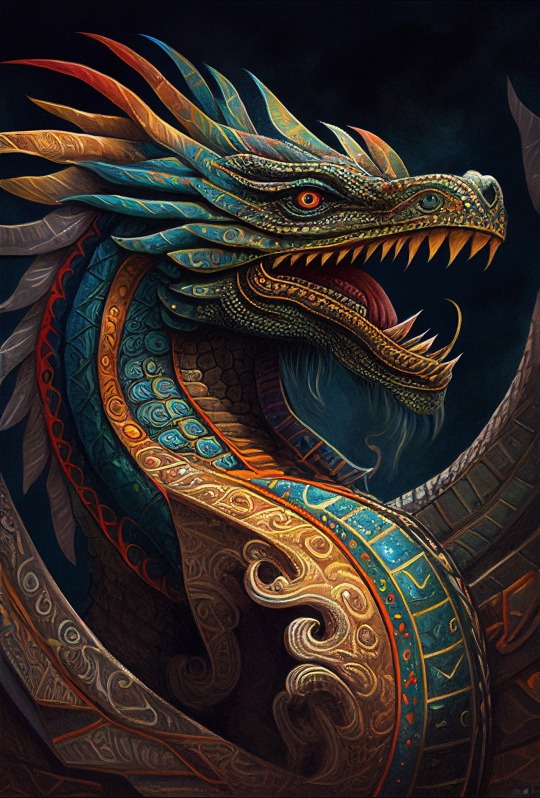
Quetzalcoatl: The Feathered Serpent
The name of the deity Quetzalcoatl comes from the Nahuatl language, and it means “Precious Serpent,” which is a reference to the serpent that is associated with the god. Quetzalcoatl was a prominent deity in the Aztec pantheon, as he was related to various phenomenon such as the planet Venus, the wind, and the sun and was also the patron of the Aztec priesthood. Aside from these, he was also associated with other gods such as Tlaloc, Huitzilopochtli, and Tezcatlipoca.
In ancient Mesoamerica, Quetzalcoatl was one of the most important gods. He was known for his role in the creation of the world and its inhabitants. His name combines the Nahuatl words coatl and quetzal. From 1200, Quetzalcoatl was regarded as the patron deity of merchants and priests in Central Mexico. He was also known for inventing the calendar and was associated with various animals, such as the opossum and also the Morning Star Venus. He also discovered a mountain full of seeds and grains.
Following the arrival of Nahua-speaking tribes in the north, Quetzalcoatl’s cult underwent significant changes. During the Toltec era, his temple was the centre of ceremonial life in the city of Tula and the culture emphasises war and human sacrifice.
Physical Traits Aside from being a plumed serpent, Quetzalcoatl was also known as a man with a beard. He was depicted as Ehécatl, the wind god, and he wore a conical hat and a mask made out of tubes.
Quetzalcoatl was also known to have a flower, a black and yellow feathered fan, jade earnings and spiral shells inside a hat-band holding sacrificial implements. He was also known to wear a cross section of a pectoral that was made from a conch whorl which was in fact a wind jewel called Ehecailacozcatl. He is often black, wears a red mask like a duck’s beak and has long canine teeth. As a god of the cardinal directions, he was associated with various colours representing each of the directions.
Family There are various stories about the life and times of the serpent. In one story, a virgin named Chimalman is said to have given birth to Quetzalcoatl after the god Onteol appeared to her in a dream. In another story, Chimalman conceived Quetzalcoatl after she swallowed an emerald. In another story, a man named Mixcoatl accidently shot an arrow into her womb and nine months later, Chimalman gave birth to a child who would later be called Quetzalcoatl. One of the stories states that Quetzalcoatl was the child of the god Coatlicue, who had hundreds of children.
According to another version of the myth, Quetzalcoatl is one of the four sons of Ometecuhtli and Omecihuatl. The four Tezcatlipocas, each of whom presides over one of the four cardinal directions are White Tezcatlipoca (Quetzalcoatl), Blue Tezcatlipoca (Huitzilopochtli), Red Tezcatlipoca (Xipe Totec) and Black Tezcatlipoca (Tezcatlipoca). It is also suggested that he was a son of Xochiquetzal and Mixcoatl.
Other Names He was known as Kukulkán to the Maya, Gucumatz to the Quiché of Guatemala, and Ehecatl to the Gulf Coast Huastecs.
Powers and Abilities Quetzalcoatl was regarded as the patron deity of merchants, priests, and scientists. In the Nahua tradition, he is also the creator of the universe and the creator of humanity. Quetzalcatl was regarded as the creator of the calendar and books as well as the protector of goldsmiths and other craftsmen. He was said to have gone to Mictlan with Xolotl to obtain the remains of the dead and was also the symbol of death and destruction. Those bones he anointed with his own blood, giving birth to the men who inhabit the present universe.
In an alternative form of creation, Quetzalcoatl and Tezcatlipoca worked together to form the first man, the rain gods, and the sun. When they were created, they transformed into snakes and ripped apart a reptilian creature known as Cipactli.
Quetzalcoatl by Talon Abraxas
21 notes
·
View notes
Text
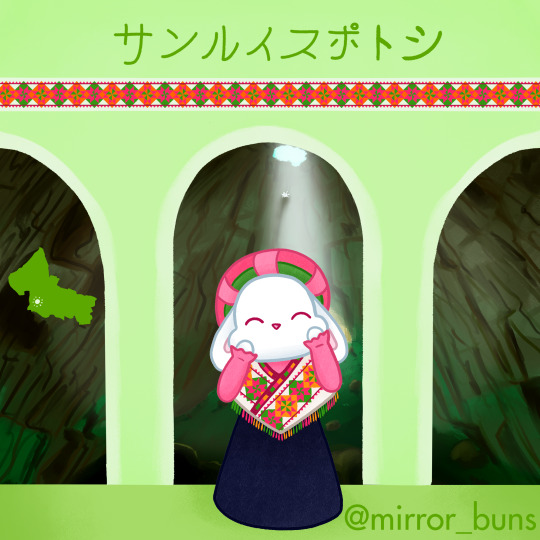
Ya faltan muy pocos estados! me toca presentar el estado de San Luis Potosí y contiene mucha cultura maravillosa, esta viene de la civilización Huasteca y nombra este hermoso vestido como "Dhayemlaab" y quién lo use se le ve un libro abierto ya que el diseño refleja parte de su vida. El color rojo significa protección contra la envidia, el rosa representa el amor, el naranja personifica la naturaleza y el verde simboliza la patria. San Luis Potosí tiene datos muy interesantes como el que la letra de nuestro himno nacional mexicano y el diseño de nuestro escudo nacional fue hecho por un potosino y el estado cuenta con muchas especies de la familia de los cactus, seguro florita le encantará conocerlos todos! Yo ando En un lugar maravilloso: El sótano de las golondrinas, quién se atreve a descender 512 metros de altura conmigo?
4 States left! It's my turn to show the state of San Luis Potosí and it is another state full of wonderful culture, it belongs to the Huastec civilization and names this lovely dress as "Dhayemlaab" And the user who wears it is known as an open book and it's design reflects as part of their lives. The red colour means protection agaisnt envy, the pink one represents love, orange means nature as a whole and green is homeland. San Luis Potosí has very interesting facts like the lyrics of our own mexican national athem and the national shield design were made by people from the state. It also has the most number of cactus species on all the country, I'm sure Flora wants to meet them all! I'm in this breathtaking place: El sotano de las golondrinas! Who dares to climb down 512 meters high with me?
#bunny#cute#kawaii#illustration#rabbit#うさぎ#drawing#kawaiiart#cute illustration#cute art#kawaiidrawing#kawaiistyle#mexico#mexican#landscape#dress
4 notes
·
View notes